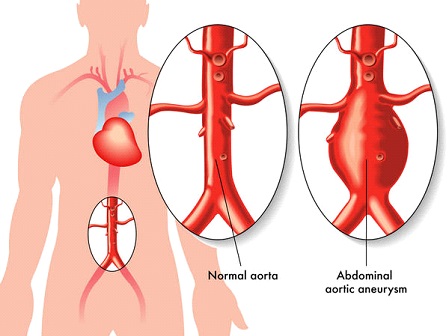Abdominal Aortic Aneurysm Symptoms, Causes, Diagnosis and Treatment

What Is Abdominal Aortic Aneurysm ?
The condition is marked by the enlarged area in the lower part of aorta. Basically, aorta is the main supplier of blood to our body, in the form of blood vessel. The blood vessel tends to run from our heart through the middle of the chest and abdomen. Being the main supplier, any damage to aorta can lead to serious effects; therefore a ruptured abdominal aortic aneurysm can result in severe bleeding.
Relying upon the size, plus the rate at which the abdominal aortic aneurysm grows, its treatment can vary. That is, from the wait-and watch approach to instant surgery. After being detected, the health care provider will regularly monitor your condition to plan the surgery, in case it becomes mandatory. Indeed, emergency surgery can be risky in the case.
What Are The Symptoms Of Abdominal Aortic Aneurysm ?
Generally, abdominal aortic aneurysm grows gradually, whilst, without any indications in most of the cases. This causes it hard to diagnose. Few aneurysms do not rupture, whereas some tends to start small and remain to the size. On the contrary, many enlarge with the passage of time. Few of which expand rapidly. Clearly, the rate of its growth is difficult to predict.
With the enlargement of abdominal aortic aneurysm, you can notice the below mentioned symptoms:
- Back pain.
- Feeling of pulsation near your navel.
- Intense, continuous pain on the side of abdomen or in the abdomen.
What Causes Abdominal Aortic Aneurysm ?
Majority of the aortic aneurysm tend to occur in the specific portion of the aorta present in the abdomen. Clearly, the precise cause of its occurrence is yet to be known, however certain factors are identified that may contribute in its instigation, these are:
- Use of tobacco.
- Atherosclerosis, a condition characterized by the hardening of arteries.
- Vasculitis, that is the infection in aorta.
What Are The Risk Factors Of Abdominal Aortic Aneurysm ?
Following factors may increase the possibility of abdominal aortic aneurysm:
- Being an older adult, who has crossed the age of sixty five.
- Consumption of tobacco, more the intake, more the chances.
- Having atherosclerosis.
- Being a man.
- Having a family history of abdominal aortic aneurysm.
What Are The Complications Of Abdominal Aortic Aneurysm ?
Abdominal aortic aneurysm can lead to the following health complications:
- Dissection (that is the tear in your aorta wall).
- Blood clots.
How Is Abdominal Aortic Aneurysm Diagnosis ?
In most cases, abdominal aortic aneurysm is detected during the examination done for some other purpose. In case the doctor doubts it, he or she will suggest the following specialized tests:
- Abdominal ultrasound.
- CT scan.
- MRI scan.
How Is Abdominal Aortic Aneurysm Treatment ?
Generally, for small aneurysm, wait and watch approach is recommended. Surgery is not the right option for such cases, as the chances of rupture increase. On the contrary, for people with large aneurysm, surgery is often suggested.
By : Natural Health News




